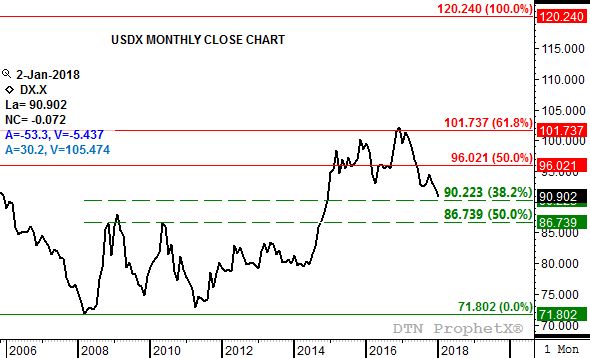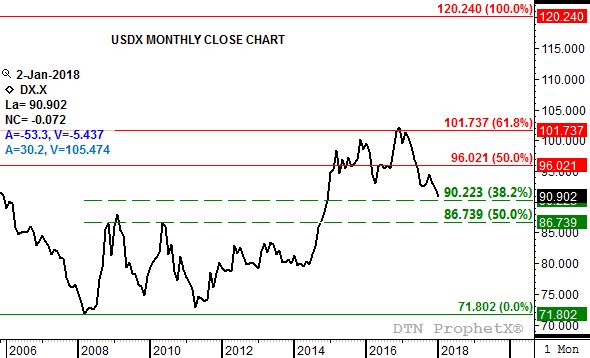Technically Speaking
Down Dollar Daze
As most of you know by now I've been a U.S. dollar bear for what seems like years. Actually, come to think of it, it has been years, predating the last rally by the U.S. dollar index (USDX) to its high monthly close of 102.21 (December 2016). Therefore I wasn't, and am still not, disappointed when the USDX did finally confirm its bearish breakdown with its close of 99.04 at the end of April 2017.
Since then the USDX has fallen quickly, as markets are want to do in comparison to how long it takes to rally. Good ol' market gravity. As we make our way through January 2018 we see that the USDX is fast approaching next major (long-term) support at 90.22 on its monthly close-only chart. This price marks the 38.2% retracement level of the previous uptrend from the March 2008 low of 71.80 through the previously mentioned December 2016 high.
P[L1] D[0x0] M[300x250] OOP[F] ADUNIT[] T[]
Recall my January 1 blog entry "The U.S. Dollar Bear in Winter". In it I pointed out the importance of USDX monthly stochastics already sitting below the oversold level of 20% as we entered the new year. The same holds true on the monthly close-only chart, meaning the ongoing major downtrend should be nearing its end.
But let's say the USDX wants to extend its downtrend beyond the 90.22 support level. What then? The next target is the 50% retracement level of 86.74. Note how that level sits near a series of peaks from November 2008 through May 2010 during the early stages of the previous uptrend.
A number of commodities have benefitted from the weakening dollar including cotton, lumber, crude oil (WTI), and gold. The common denominator of these different commodities, besides the weaker dollar, has been increasingly bullish fundamentals reflected in the markets' respective forward curves (most notably the inverses/backwardation in lumber and Brent crude).
Noticeably lacking from this list of bullish commodities is the grain and oilseed complex. Again, it comes down to bearish fundamentals (strong carry/contango in forward curves) proving to be unattractive to noncommercial (speculative, fund, etc.) traders. For further proof take a look at the most recent CFTC Commitment of Traders report (legacy, futures only). There you'll see the noncommercial classification holding net-short futures positions in corn, soybeans, Chicago SRW wheat, and rice. On the other hand, this groups large net-long futures positions in markets like crude oil, cotton, and gold continue to grow.
To track my thoughts on the markets throughout the day, follow me on Twitter:www.twitter.com\Darin Newsom






Comments
To comment, please Log In or Join our Community .